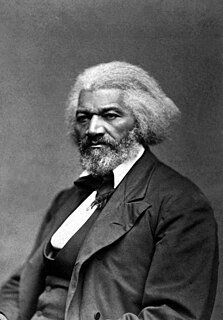 W
WFrederick Douglass was an American social reformer, abolitionist, orator, writer, and statesman. After escaping from slavery in Maryland, he became a national leader of the abolitionist movement in Massachusetts and New York, becoming famous for his oratory and incisive antislavery writings. Accordingly, he was described by abolitionists in his time as a living counterexample to slaveholders' arguments that slaves lacked the intellectual capacity to function as independent American citizens. Likewise, Northerners at the time found it hard to believe that such a great orator had once been a slave.
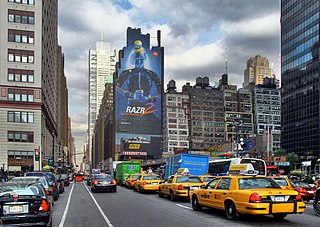 W
WEighth Avenue is a major north–south avenue on the west side of Manhattan in New York City, carrying northbound traffic below 59th Street. It is one of the original avenues of the Commissioners' Plan of 1811 to run the length of Manhattan, though today the name changes twice. At 59th Street/Columbus Circle it becomes Central Park West, where it forms the western boundary of Central Park. North of 110th Street/Frederick Douglass Circle it is known as Frederick Douglass Boulevard before merging onto Harlem River Drive north of 155th Street.
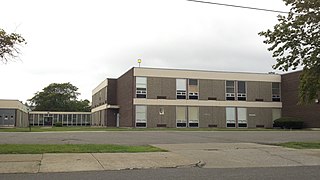 W
WFrederick Douglass Academy for Young Men is a Detroit, Michigan grade 6-12 school exclusively for boys. It is a part of Detroit Public Schools (DPS), and it is the only all-male public school in the State of Michigan. It is named after Frederick Douglass and it is located in Woodbridge, in the former Murray–Wright High School.
 W
WDouglass Park is a large Chicago Park District park that serves as a cultural and community center on the West Side of Chicago, Illinois. Established in 1869 and initially named South Park, its 173 acres (0.70 km2) are in the North Lawndale community area with an official address of 1401 S. Sacramento Drive.
 W
WFrederick Douglass Circle is a traffic circle located at the northwest corner of Central Park at the intersection of Eighth Avenue and 110th Street in the New York City borough of Manhattan. The traffic circle is named for the American abolitionist, women’s suffragist, editor, orator, author, statesman, and reformer Frederick Douglass.
 W
WThe Fugitive Slave Law Convention was held in Cazenovia, New York, August 21–22, 1850. Organized to oppose passage of the Fugitive Slave Act of 1850 by the United States Congress, participants included Frederick Douglass, the Edmonson sisters, Gerrit Smith, Samuel Joseph May, Theodore Dwight Weld, and others.
 W
WShields Green, who also referred to himself as "'Emperor"', was, according to Frederick Douglass, an escaped slave from Charleston, South Carolina, and a leader in John Brown's raid on Harpers Ferry, in October 1859. He had lived for almost two years in the house of Douglass, in Rochester, New York, and Douglass introduced him there to Brown.
 W
WThe Nathan and Mary (Polly) Johnson properties are a National Historic Landmark at 17–19 and 21 Seventh Street in New Bedford, Massachusetts. Originally two structures, one dating to the 1820s and an 1857 house joined with the older one shortly after construction. They have since been restored and now house the New Bedford Historical Society. The two properties are significant for their association with leading members of the abolitionist movement in Massachusetts, and as the only surviving residence in New Bedford of Frederick Douglass. Nathan and Polly Johnson were free African-Americans who are known to have sheltered escaped slaves using the Underground Railroad from 1822 on. Both were also successful in local business; Nathan as a [caterer] and Polly as a confectioner.
 W
WThe Frederick Douglass Memorial Bridge is a swing bridge that carries South Capitol Street over the Anacostia River in Washington, D.C. It was built in 1950 and in 1965 named after abolitionist Frederick Douglass. In 2007, the bridge was used by 77,000 daily commuters.
 W
WMetropolitan African Methodist Episcopal Church is a historic church located at 1518 M Street, N.W., in downtown Washington, D.C. It affiliates with the African Methodist Episcopal Church.
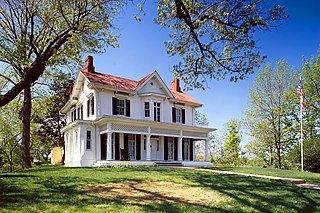 W
WThe Frederick Douglass National Historic Site, administered by the National Park Service, is located at 1411 W Street, SE, in Anacostia, a neighborhood east of the Anacostia River in Southeast Washington, D.C. Established in 1988 as a National Historic Site, the site preserves the home and estate of Frederick Douglass, one of the most prominent African Americans of the 19th century. Douglass lived in this house, which he named Cedar Hill, from 1877-1888 until his death in 1895. Perched on a hilltop, the site offers a sweeping view of the U.S. Capitol and the Washington, D.C., skyline.
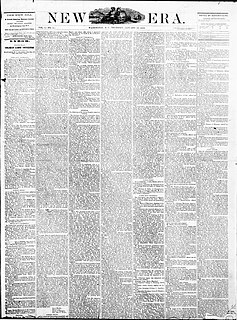 W
WNew National Era, originally the New Era and partly near the end as New National Era and Citizen, was a national newspaper for African Americans published in Washington D.C. during the Reconstruction Era in the decade after the American Civil War and Emancipation Proclamation. Frederick Douglass took over the New Era in 1870 and renamed it New National Era. The New York Heritage Digital Collections has issues of the paper from 1870 until 1874. The Library of Congress also has issues in its collection. The papers editors were Frederick Douglass (1870–1872), his son Lewis H. Douglass, (1873–1874) as well as Richard T. Greener, and John A. Cook (1873).
 W
WThe North Star was a nineteenth-century anti-slavery newspaper published from the Talman Building in Rochester, New York, by abolitionist Frederick Douglass. The paper commenced publication on December 3, 1847, and ceased as The North Star in June 1851, when it merged with Gerrit Smith's Liberty Party Paper to form Frederick Douglass' Paper. At the time of the Civil War, it was Douglass' Monthly. The North Star's slogan was: "Right is of no Sex—Truth is of no Color—God is the Father of us all, and all we are Brethren."
 W
WFrederick Douglass High School, established in 1883, is an American public high school in the Baltimore City Public Schools district. Originally named the Colored High and Training School, Douglass is the second-oldest U.S. high school created specifically for African American students. Prior to desegregation, Douglass and Paul Laurence Dunbar High School were the only two high schools in Baltimore that admitted African-American students, with Douglass serving students from West Baltimore and Dunbar serving students from East Baltimore.
 W
WSojourner–Douglass College was a private college organized around an Afrocentric focus of study and located in Baltimore, Maryland. The college was founded in 1972 and focused on educating mature students. The college's accreditation was revoked by the Middle States Association of Colleges and Schools effective June 30, 2015, and the college remains closed for instruction.
 W
WThe Strivers' Section Historic District is a historic district located in the Dupont Circle neighborhood of Washington, D.C. Strivers' Section was historically an enclave of upper-middle-class African Americans, often community leaders, in the late 19th and early 20th centuries. It takes its name from a turn-of-the-20th-century writer who described the district as "the Striver's section, a community of Negro aristocracy." The name echoes that of Strivers' Row in Harlem, a New York City historic neighborhood of black professionals. The district is roughly bounded by Swann Street and the Dupont Circle Historic District on the south, Florida Avenue and the Washington Heights Historic District on the north and west, and the Sixteenth Street Historic District on the east.
 W
WDouglass is a residential neighborhood in Southeast Washington, D.C., on the eastern side of St. Elizabeths Hospital, on the border of the Congress Heights Metro Station. It is bounded by Suitland Parkway to the north and east, Alabama Avenue to the south, and the St. Elizabeths campus to the west.